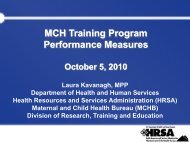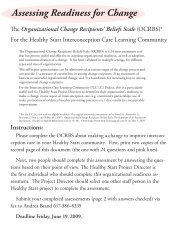60 performance measures with operational definitions (PDF) - HRSA
60 performance measures with operational definitions (PDF) - HRSA
60 performance measures with operational definitions (PDF) - HRSA
Create successful ePaper yourself
Turn your PDF publications into a flip-book with our unique Google optimized e-Paper software.
# Measure Numerator Denominator IOM Quality Donabedian Diagnosis Measure Required Data Elements Notes /Reference<br />
Domain Framework Category Level*<br />
* (A)Individual Clinician or Group of Clinicians (e.g. nurses, residents, attendings, fellows); (B) Facility (ED); (C) System-Wide Measure<br />
Pain and Sedation<br />
5.1 Topical anesthetics for Number of face or scalp lacerations receiving Number of facial or Effective, Process Cross-cutting A, B Unique visit identifier<br />
pediatric laceration topical anesthesia prior to suture or staple scalp lacerations Patient-<br />
(pain),<br />
Medication name<br />
repair<br />
repair in patients < 18 years of age<br />
undergoing suture Centered<br />
lacerations<br />
CPT code (for<br />
or staple repair in<br />
suture/staple procedure)<br />
patients < 18 years<br />
ICD-9 code (identifies<br />
of age<br />
laceration patients)<br />
5.2 Effective pediatric Number of patients < 18 years of age Number of Effective, Process Cross-cutting A, B All of the following criteria must be present for a sedation<br />
procedural sedation meeting criteria for effective procedural<br />
sedation<br />
procedural<br />
sedations<br />
performed in<br />
patients < 18 years<br />
of age<br />
Patient-<br />
Centered<br />
(pain)<br />
to be considered effective:<br />
a) The patient does not have unpleasant recall of the<br />
procedure.<br />
b) The patient did not experience sedation-related adverse<br />
events resulting in abandonment of the procedure or a<br />
permanent complication or an unplanned admission to the<br />
hospital or prolonged ED observation<br />
c) The patient did not actively resist or require physical<br />
restraint for completion of the procedure. The need for<br />
minimal redirection of movements should not be<br />
considered as active resistance or physical restraint.<br />
-Responses to these 3 criteria may be included as part of the<br />
ED procedural sedation record.<br />
Reference: Roback et al. (2009). Consensus-Based<br />
Recommendations for Standardizing Terminology and<br />
Reporting Adverse Events for Emergency Department<br />
Procedural Sedation and Analgesia in Children. Annals of<br />
Emer. Med:53(4)<br />
5.3 Documenting age Number of patients < 18 years of age <strong>with</strong> Number of patients Effective, Outcome Cross-cutting A, B Unique visit identifier -Examples of age appropriate pain scores include; NPASS,<br />
appropriate pain<br />
scores<br />
an age appropriate pain score documented < 18 years of age<br />
presenting to the<br />
Patient-<br />
Centered<br />
(pain)<br />
Presence of pain y/n<br />
Type of pain scale used<br />
FLACC, Bieri faces pain scale and verbal analogue scale<br />
(VAS).<br />
who screen positive<br />
for pain<br />
Pain score<br />
5.4 Treating and Number of patients < 18 years of age <strong>with</strong> a Number of patients Effective, Process Cross-cutting A, B Unique visit identifier -Examples of age appropriate pain scores include; NPASS,<br />
reassessing pain pain intervention and reassessment <strong>with</strong>in 90<br />
minutes of initial age-appropriate positive<br />
< 18 years of age<br />
presenting to the<br />
Timely,<br />
Patient-<br />
(pain)<br />
Pain score<br />
Pain score assessed time<br />
FLACC, Bieri faces pain scale and verbal analogue scale<br />
(VAS).<br />
pain score<br />
who screen positive Centered<br />
Pain intervention<br />
for pain<br />
documented<br />
5.5 Reducing pain in Number of patients < 18 years of age <strong>with</strong> Number of patients Effective, Process Cross-cutting A, B Unique visit identifier -Examples of age appropriate pain scores include; NPASS,<br />
children <strong>with</strong> acute<br />
fractures<br />
pain assessed and reassessed using the same<br />
age-appropriate pain scale who show<br />
< 18 years of age<br />
<strong>with</strong> acute long-<br />
Timely,<br />
Patient-<br />
(pain), fractures<br />
ICD-9 code<br />
Pain score<br />
FLACC, Bieri faces pain scale and verbal analogue scale<br />
(VAS).<br />
documented improvement in pain score<br />
<strong>with</strong>in 90minutes of arrival<br />
bone fractures Centered<br />
Pain score assessed time<br />
8 of 16




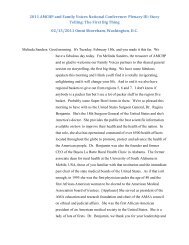


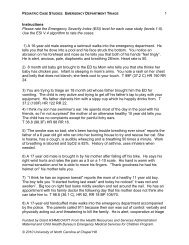
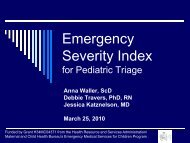
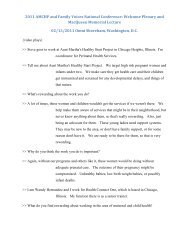
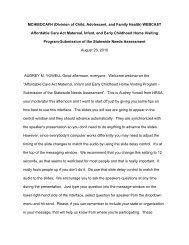
![Hormone Disruptors and Women's Health: Reasons for Concern [PDF]](https://img.yumpu.com/19410002/1/190x245/hormone-disruptors-and-womens-health-reasons-for-concern-pdf.jpg?quality=85)

